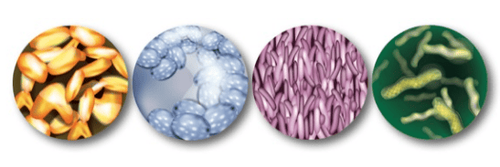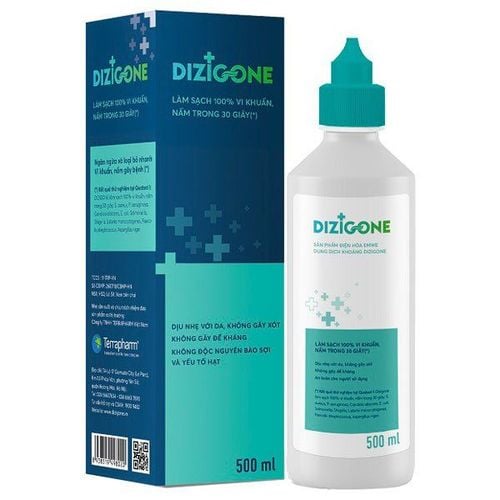This is an automatically translated article.
Post by Master, Doctor Mai Vien Phuong - Gastrointestinal endoscopy - Department of Medical Examination & Internal Medicine - Vinmec Central Park International General Hospital.Interest in regulating the gut microbiome by consuming foods or the microbiome that could improve overall health dates back to the early 1900s. When it was hypothesized that some Milk and yogurt can provide health benefits to those who consume them.
1. Overview
Interest in regulating the gut microbiome by consuming foods or the microbiome that could improve overall health dates back to the early 1900s. When it was hypothesized that some Milk and yogurt can provide health benefits to those who consume them.
As an understanding of the gut microbiome and the complex interactions involved in inflammation, intestinal permeability, and metabolic dysfunction, the potential of probiotics is appealing to clinicians and patient. However, while enthusiasm for probiotics has skyrocketed, especially along with other highly advertised nutritional supplements, little data supports their use. Perhaps more importantly, the gastrointestinal diseases for which they have benefits and the species that confer these benefits are still unclear, leading to confusion between clinicians and the general public.
2. Gut microbiota is involved in many digestive diseases
2.1 Role of probiotics in Crohn's disease and ulcerative colitis
Changes in the gut microbiome have been shown to play a role in the pathogenesis of Crohn's disease (Crohn's disease) and ulcerative colitis. For many of the other indications discussed, there is a lack of strong evidence for IBD because of small sample sizes, variations in probiotic regimens, or differences in dosage. However, the use of the VSL component
3 has shown some efficacy in inducing remission in mild to moderate ulcerative colitis. In a randomized controlled study (N = 147), many patients with mild-to-moderate active ulcerative colitis taking VSL
3 (900 billion bacteria/day) experienced a 50% improvement in activity index. activity of ulcerative colitis compared with those receiving placebo after 6 weeks (32.5% vs 10.0%; P = 0.001). At week 12, 42.9% of patients receiving VSL
3 were in remission compared with 15.7% of patients receiving placebo (P<0.001). A meta-analysis found that VSL
3, when added to conventional therapy at a dose of 3.6 × 10 12 CFU/day, was safer and more effective than conventional therapy alone in achieving response and remission rates were higher in patients with mild to moderate disease.
The literature also suggests that VSL
3 can reduce recurrence rates in already quiet ulcerative colitis. A randomized controlled study looked at the use of supplemental VSL
3 (450-1,800 billion bacteria based on weight/day) with 5-aminosalicylate in maintaining remission in a small cohort of pediatric patients. had mild to moderate ulcerative colitis (N=29).
Fewer patients treated with VSL
3 relapsed within 1 year of follow-up (21.4% vs 73.3%). At 6 months, 12 months and time to relapse, endoscopic and histological scores were lower in VSL
3 group. In addition, in 2 randomized controlled trials, E. coli Nissle 1917 was used. at a dose of 200 mg daily (2.5-25 × 10 live bacteria per capsule) for 12 months was found to be at least as effective as mesalamine in preventing recurrence of ulcerative colitis in no time. symptomatic in patients followed for more than 1 year. Furthermore, there were no significant differences between mesalamine and E. coli Nissle 1917 in terms of safety measures and tolerability in patients with ulcerative colitis. The AGA recommends the use of probiotics only in ulcerative colitis in the clinical trial setting due to the lack of large randomized controlled studies and the cost of VSL
3.
In Crohn's disease, again, the data are very limited. little and no significant difference between any of the probiotic strains studied alone and placebo or less optimistically, showing worse outcomes than standard medical therapies. In a small randomized controlled study, a 2 × 10 11 CFU dose of live B. longum lyophilized in one gelatin capsule and one sachet containing 6 g Synergy I (Orafti), administered twice daily for 6 months, led to improved endoscopy and histological score of Crohn's disease compared with placebo alone. 41 This intervention, however, did not lead to an improvement in the patient's reported symptoms. At the time of this writing, there are no data recommending probiotics alone in the maintenance or onset of Crohn's disease, and the AGA recommends only probiotics in Crohn's disease in the clinical trial setting. .
Another approach to microbiome regulation in Crohn's disease is diet-based therapy. A multinational head-to-head randomized controlled study that looked at a whole-food diet with partial enteral nutrition (EN) versus EN specifically for standard care in pediatric patients with mild to moderate Crohn's disease. Both diets were effective in remission by week 6, and the combined Crohn's disease elimination plus partial EN diet resulted in sustained remission in a significantly higher proportion of patients than EN. to exclude, to expel. The combination also produced changes in the fecal microbiota associated with remission (decreased in Haemophilus, Veillonella, Anaerotipes and Prevotella, and increased in Roseburia and Oscillibacter).

2.2. Role of probiotics in irritable bowel syndrome
Although data supporting probiotics for IBS are generally limited largely by methodological shortcomings, there is some support for their use for variant diarrhea (IBS-D). Studies examining several species of Lactobacillus, including LPO1, and L. plantarum 299V, as well as B. bifidum MIMBb75, B. breve BR, and VSL
3, have also shown improvement in patient-reported symptoms. , including gas and bloating, but did not show an overall effect on stool quality or frequency.
2.3. Role of probiotics in low birth weight preterm infants
One of the most attractive indications for probiotics is the prevention of necrotizing enterocolitis (NEC) in at-risk low birth weight premature infants (<37 weeks of age). NEC is an emergency condition associated with intestinal necrosis, which can lead to short bowel syndrome and neurodevelopmental impairment. The microbiome composition is different in children with NEC compared with healthy children, providing a possible therapeutic intervention with probiotics. Recommended combinations include Lactobacillus species and Bifidobacterium species (L. rhamnosus ATCC 53103 and B. longum subspecies infantis; L. casei and B. breve; L. rhamnosus, L. acidophilus, L. casei, B. longum subspecies infantis, B. bifidum, and B. longum subspecies longum; L. acidophilus and B. longum subspecies infantis; L. acidophilus and B. bifidum; L. rhamnosus ATCC 53103 and B. longum Reuter ATCC BAA-999; Subspecies L. acidophilus, B. bifidum, B. animalis lactis, and subspecies B. longumlongum; subspecies B. animalis lactis [including DSM 15954]; L. reuteri [DSM 17938 or ATCC 55730]; or L. rhamnosus [ ATCC 53103 or ATC A07FA, or LCR 35]). These regimens were found to reduce all-cause mortality compared with placebo.

3. Caution and consideration with probiotics
It is imperative that clinicians weigh and discuss contraindications and risks when recommending and prescribing probiotics to patients. Hypothetically, probiotics can translocate, cause bacteremia or fungal infections, as well as contaminate the product and should be used with caution in immunocompromised, hospitalized, or postoperative patients. . In addition, commercially available probiotics may be contaminated with allergens, such as cow's milk protein, and should be avoided in patients with severe allergies.
A summary from the Celiac Disease Center presented at Digestive Diseases Week 2018 shows that there is significant gluten contamination of probiotics, and celiac patients should use these products with caution. In addition, there are insufficient safety data on the use of probiotics during pregnancy, although studies published to date have not found any causative agents. Pregnant women should also avoid any unpasteurized products.
Another important consideration when advising patients about probiotics is the benefit of eating yogurt as a source of probiotics. Some yogurts made in the United States are pasteurized, a process that kills live bacteria. In addition, studies have shown that the bacteria living in yogurt may not survive at the low pH of the product, they may not survive prolonged storage or gastric transit. acidic and they may not resist breakdown in the small intestine by hydrolytic enzymes and bile salts. It is not known how many live bacteria reach the distal intestine and enter the microbiome following the above processes, leading to questions about the clinical utility of yogurt consumption on probiotic content. . Other foods to consider containing live cultures include kimchi (a Korean fermented cabbage dish), sauerkraut (fermented cabbage), miso (a fermented soybean paste) , pickles, kombucha (a fermented tea) and apple cider vinegar (made from fermented apple sugar).
The data are still strongest on the use of probiotics in pouchitis at 3g daily VSL
3 for primary prevention and 6g daily for secondary prevention. There is not enough evidence to use probiotics to treat C. difficile infections, but there are probiotic regimens that are effective as a preventive measure in patients when they are on antibiotic therapy. Evidence for microbiome control therapy in IBS and hepatic encephalopathy is promising. In IBD, probiotics may be considered to initiate remission and maintain in mild to moderate ulcerative colitis.
When discussing probiotic use with patients, be sure to consider the risks, benefits, and contraindications of their use. Consider concentrated, rigorously tested probiotic strains, in addition to foods that can provide live bacteria during the initial digestive phase. Ensure patients are on the correct regimen for proper indications and note that data on other diseases are preliminary and are likely to increase in the coming years. Also, keep an eye out for probiotic strain and dosage recommendations that will change as research continues in this rapidly growing field.
Please dial HOTLINE for more information or register for an appointment HERE. Download MyVinmec app to make appointments faster and to manage your bookings easily.
ReferencesBrown AC, Valiere A. Probiotics and Medical Nutrition Therapy. Nutr Clin Care . 2004; 7 (2): 56-68. Rousseaux C, Thuru X, Gelot A, et al. Lactobacillus acidophilus modulates intestinal pain and produces opioid and cannabinoid receptors. Nat Med. 2007; 13 (1): 35-37. Sokol H, Pigneur B, Watterlot L, et al. Faecalibacterium prausnitzii is an anti-inflammatory commensal bacterium identified by analysis of the gut microbiota of patients with Crohn's disease. Proc Natl Acad Sci USA . 2008; 105 (43): 16731-16736. McCarthy J, O'Mahony L, O'Callaghan L, et al. Double-blind, placebo-controlled trial of two rat probiotic strains interleukin 10 and its mechanical association with cytokine balance. Intestine . 2003; 52 (7): 975-980. https://www.gastroendonews.com/














